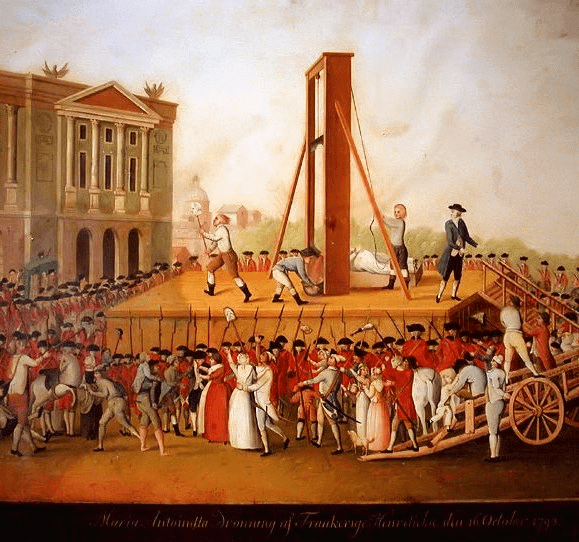Class 9 History Chapter 1 Previous Year Questions - The French Revolution
Short Answer Type Questions
Q.1. What was the Bastille?
Who had stormed the Bastille during the last years of the 18th century? [2024]
Ans. The Bastille was the fortress-prison that was stormed by the people of Paris on 14 July 1789. Storming of Bastille
Storming of Bastille
Q.2. Who wrote the Declaration of the Rights of woman and citizen? [2024]
Ans. Olympe de Gouges wrote a Declaration of the Rights of woman and citizen in 1791.
Q.3 What was the name give to newly-elected assembly of the Jacobins? [2023]
Ans. The newly elected assembly of the Jacobins was called the Convention. It abolished the monarchy and declared France a republic. Montesquieu
Montesquieu
Q.4 Who wrote The Spirit of the Laws? [2022]
Ans. The Spirit of the Laws was written by Montesquieu.
Q. 5 Which ruler came to power in France in 1774? [2022]
Answ. Louis XVI of the Bourbon family ascended the throne of France in 1774.
Q.6. Which social group emerged in France in the 18th century? [2021]
Ans. The middle class emerged in France in the 18th century.
Q. 7 What did John Locke write in his book Two Treaties of Government? [2020]
Ans. John Locke sought to refute the doctrine of the divine and absolute right of the monarch in his book.
Q.8 What was the most revolutionary reform of the Jacobin regime? [2020]
Ans. The most revolutionary reform of the Jacobin regime was the abolition of slavery in the French colonies.
Q.9 Which principle was followed by Estate General for taking vote? [2019]
Ans. According to the principle, each estate has one vote.
Q.10 What was Marseillaise? Who composed it? [2018]
Ans. Marseillaise was one of the patriotic songs sung by volunteers from Marseilles as they marched into Paris and got its name. It was composed by Rouget de Lisle. It is now the national anthem of France.
Long Answer Type Questions
Q.1. Explain the “Reign of Terror” in brief. [2019]
Ans.
The following points explain the Reign of Terror:
(a) The period from 1793 to 1794 is called the Reign of Terror because Robespierre followed a policy of severe control and punishment. Ex-nobles, clergy, members of other political parties, and even the members of his own party, who did not agree with his methods, were arrested, imprisoned, and guillotined. Guillotine(b) Laws were issued by Robespierre's government laws were issued by placing a maximum ceiling of wages and prices. Meat and bread were rationed.
Guillotine(b) Laws were issued by Robespierre's government laws were issued by placing a maximum ceiling of wages and prices. Meat and bread were rationed.
(c) Peasants were forced to transport their grain to the cities and sell it at prices fixed by the government. The use of more expensive white flour was forbidden; all citizens were required to eat equal bread.
(d) Equality was also sought to be practiced through forms of speech and address. Instead of the traditional Sir and Madam, French men and women were addressed as citizens.
(e) Churches were shut down and their buildings converted into barracks or offices. Finally, Robespierre was convicted by a court in July 1794, arrested, and the next day, sent to the guillotine.
Q.2. Explain the features of the constitution of France drafted in 1791. [2018]
Ans.
- The constitution of 1791 was the first written constitution in France, created after the collapse of absolute rule.
- Its main aim was to limit the powers of the monarch.
- Powers were then divided/separated and assigned to different institutions like legislative, executive and judiciary.
- According to this, active citizens of France elected electors who in turn voted to elect the National Assembly.
- Not all citizens had the right to vote. Only men of 25 years of age who paid taxes equal to at least three days of a labourer’s wage. They were called active citizens.
- The remaining men and all women were called the passive citizens.
- The National Assembly controlled the king. France became a constitutional monarchy.
Q.3. How was the National Assembly recognised and how did it start exercising its powers? [2017]
Ans. Faced with revolting people, Louis XVI recognised the National Assembly and accepted that his powers would from now on be checked by the constitution. National Assembly started exercising its power in the following ways.
(a) On the night of 4 August, 1789, the Assembly passed the law for abolishing feudal system of obligations and taxes, the clergy members were also forced to give up their privileges.
(b) Tithes were abolished and lands owned by the Church were seized and all this resulted in acquiring assets worth at least 2 billion livres.
Q.4 How did philosophers influence the thinking of the people of France? [2016]
Ans.
 The philosophers influenced the thinking of the people of France in the following ways:
The philosophers influenced the thinking of the people of France in the following ways:
(a) Philosophers such as John Locke and Jean Jacques Rousseau put forward ideas envisaging a society based on freedom and equal laws and opportunities for all.
(b) In Two Treatises of Government, John Locke sought to refute the doctrine of the divine and absolute rights of the monarch.
(c) His ideas were carried forward by Rousseau as he was proposing a form of government based on social contract between the people and their representatives.
(d) In The Spirit of the Laws, Montesquieu proposed a division of power within the government between the legislative, the executive and the judiciary.
(e) The ideas of these philosophers were discussed intensively in salons and coffee-houses and were spread among people through books and newspapers.
Q.5 Describe the middle class in three points. [2016]
Ans.
The following points describe the middle class in French society.
(a) The middle class was a social group that emerged in France in the 18th century. This class made money through an expanding overseas trade and by manufacturing goods like woollen and silk textiles.
(b) The middle class, along with merchants and manufacturers, included professionals like lawyers and administrative officials.
(c) All these people were educated and believed that no group in society should be privileged by birth and a person’s position in society should be based on his merit.
|
53 videos|437 docs|80 tests
|
FAQs on Class 9 History Chapter 1 Previous Year Questions - The French Revolution
| 1. What were the main causes of the French Revolution? |  |
| 2. What role did the Enlightenment play in the French Revolution? |  |
| 3. What were the major events that marked the French Revolution? |  |
| 4. How did the French Revolution impact the rest of the world? |  |
| 5. What were the outcomes of the French Revolution? |  |

























